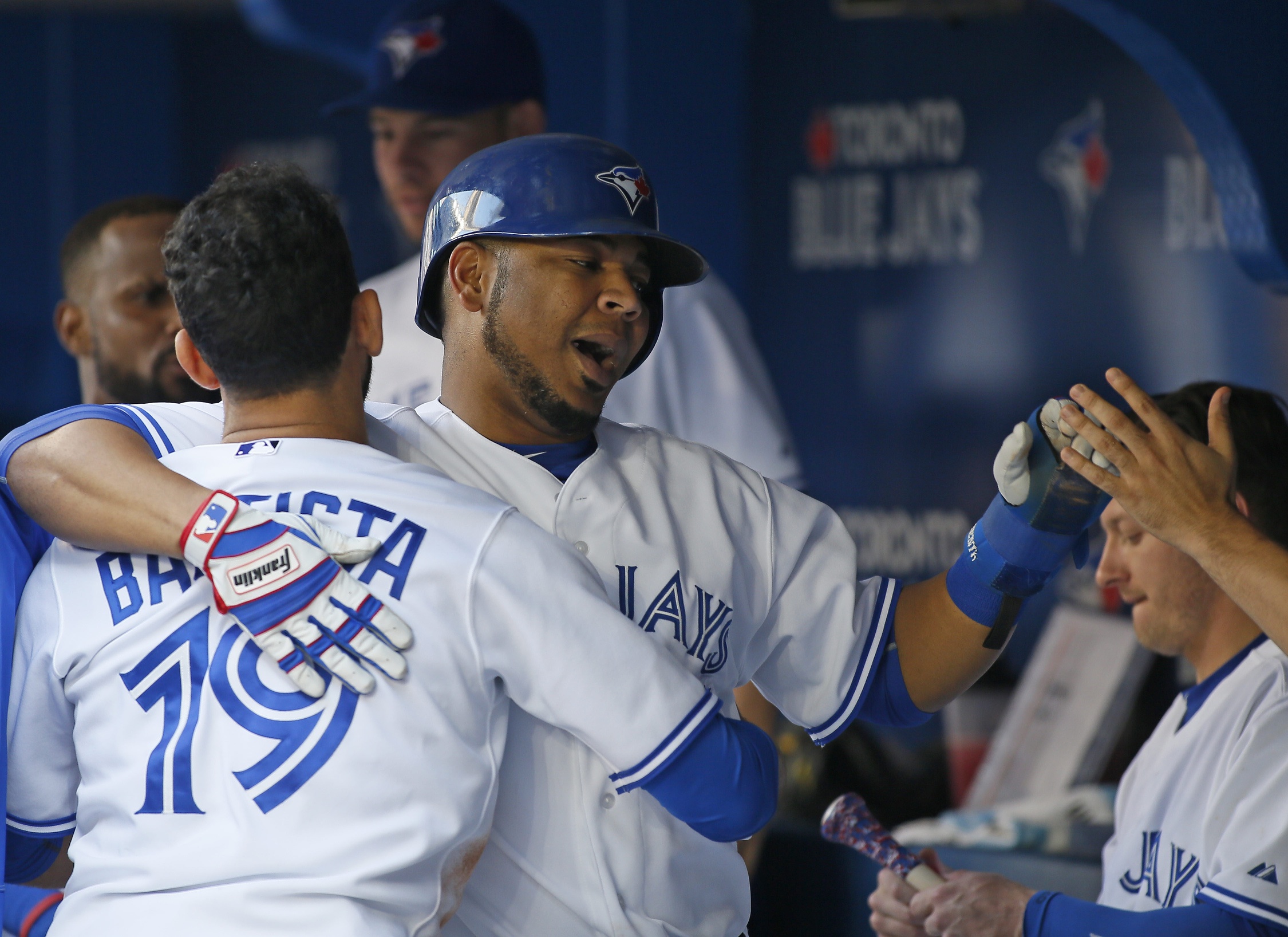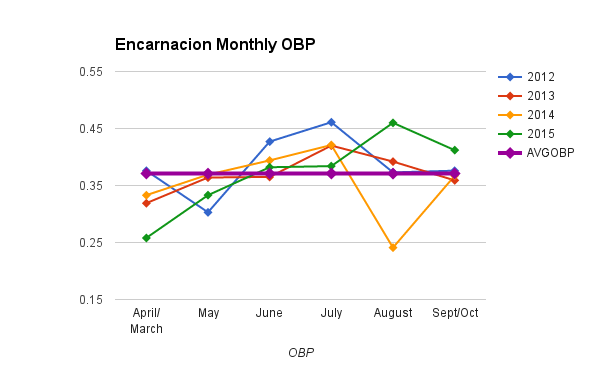With Edwin Encarnacion having dealt with both an abscessed tooth and an oblique injury this spring, we haven’t seen him at all. Well, we’ve seen him, but mostly in interviews about how he, like most other players facing free agency, is unimpressed that the team has not yet handed him years and dollars on a contract to his liking.
The reason, I’m sure, that Encarnacion believes he should get those guaranteed dollars and years is because he’s one of the most consistent power hitters in baseball. Since he came into his own in 2012, he has a triple slash line of .274/.371/.549. He has averaged 76 walks and 84 strikeouts a year, in addition to 38 home runs and 106 RBI. When you put that all together, you get the 150 OPS+ that he’s put up over that same time, which means that he’s been 50% better than the average hitter. If that’s not impressive, I don’t know what is.
Encarnacion hardly ever strays from those average numbers. His range of batting averages? .268 to .280. OBP? .354 to .384. SLG? .534 to .537. His slugging percentage, in fact, was exactly .557 in two different years. He has never walked fewer than 62 times, or more than 84. He has struck out between 62 and 98 times over those four seasons. He bottoms out at 34 home runs, and tops out at 42. He has driven in as few as 98, and as many as 111. You could set your calendar by this man. He does the same thing every year. That is, if your calendar only counted by the year and ignored the individual months.
You see, even though it all works out in the end, in an oddly inexplicable way, the route that Encarnacion takes to get to a very similar, and very impressive set of numbers every year can be very indirect. In order to try and figure out when we might expect Encarnacion to be comfortably hot (or possibly just to stop us from tearing our hair out when he’s not) I propose a graphical trip down memory lane.
This first chart shows Encarnacion’s OBP by month for each of the last four years.
I have included a line for his average OBP as well, as a reference.
Clearly, in terms of his ability to get on base, the ‘slow starter’ characterization is absolutely true. Only once in this time range has EE had an April where he even came close to his average OBP. Surprisingly, the cold stays with him into May too. Although his values track closer to a league average, that’s not what we (or Encarnacion himself) are looking for. June and July are his hottest months. August, too, is a strong month for Edwin, and the only abberration in that list is 2014, a year in which he was injured from July 5 to August 15, and he performed poorly upon his return. Arguments were made that he came back too early because the team was desperate for offensive help. Lastly, we have September, where it looks like EE may wear down a bit, even when presented with the lower tier of pitching that comes with expanded rosters.
Home runs are, of course, a much more fickle thing to predict, as the sample size is very small in any given month. However, the history is there, so let’s see if there is a pattern of any kind.
The median line is the median number of home runs that EE has hit in that particular month over the four year span in question. The ‘slow start’ accusations were justified in 2014 and 2015, but don’t seem particularly apt in 2012 or 2013. Overall, May looks like the best month to hope for big home run numbers from him. I’ve used median instead of mean in order to minimize the upward skewing effect of his AL record 16 home runs in May of 2014.
Strangely, as OBP goes up in June and July, the HR power fades a bit. Are teams pitching around Edwin once they perceive he’s become a real threat? Or is he more selective once he’s settled in? That’s an answer for another article. However, if we assume a healthy Edwin, and ignore 2014, we see he drives the ball with authority right through the end of the season; even if his patience at the plate wavers a little.
With that all said, it’s important to note that we’re dealing with some pretty small samples all across the board here. However, if you were to insist on a prediction from me, given Edwin’s late start to spring training, I’d venture that we’ll see a slow April and mediocre May from our resident first baseman/designated hitter. From then on, everything else points to on an elite OBP around or even over .400 for June and July. In fact, it wouldn’t hurt to flip Edwin and Bautista in June and July, just to see if the team can score even more runs when EE has more often got on base, and less often homered. Home runs are much, much harder for me to say anything definitive about. At some point, you can cross your fingers and hope for a month with more than ten home runs, because those are pretty unusual for Encarnacion, but they do come around.
As we talked about at the beginning, Edwin Encarnacion is a perplexing player because he’s inconsistently consistent. It seems that no matter what happens, he’ll be one of the better hitters in the league, but that good hitting won’t be distributed evenly. He’ll also probably play in a lot a games, but not every game. In the four year span that we looked at, Eddie has never played fewer than 128 or more than 151. He’s figured out how, despite some nagging health issues, to stay on the field and be productive for the vast majority of the Blue Jays’ games. He’ll never be the as predictable as you might wish, but he’s always going to be someone who you’ll want around.
Lead Photo: John E. Sokolowski-USA TODAY Sports


